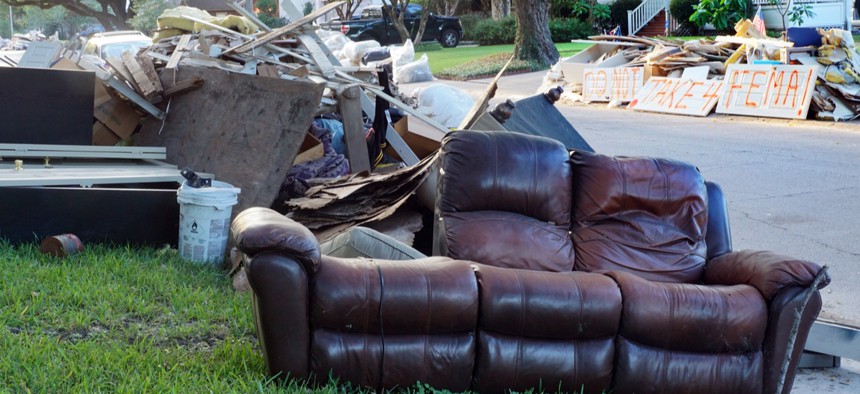In Houston, a Focus on Innovation to 'Build Back Better'

Debris from a flooded Houston neighborhood following Hurricane Harvey in August 2017. Shutterstock

Connecting state and local government leaders
Hurricane Harvey focused the city's efforts to use technology, citizen engagement and lessons from around the world to steer its disaster response and address long-term needs.
HOUSTON — When it comes to technology and innovation, big things have been happening in Houston for years. But when Hurricane Harvey hit, those big things took on new meaning. In many ways, it was this entrepreneurial spirit that helped us weather the storm – and it’s helping us build back better, too.
Just like Steve Jobs didn’t create the computer and Elon Musk didn’t create the car, we’re not trying to recreate the wheel. Instead, just like those renowned entrepreneurs, we’re looking to take proven solutions and apply them to Houston’s unique challenges in our new, post-Harvey reality.
One of the biggest lessons I learned from Hurricane Harvey is the power of the crowd. During the storm, Sketch City, a local tech community of civic hackers, embedded with Mayor Sylvester Turner and other Houston city officials.
In real time, they developed ad-hoc technologies that addressed citizens’ immediate needs. Their members created a database and API (called Harvey Needs) that paired individuals needing rescue and resources with volunteers and City services. Using crowd sourced tools, volunteers rescued over 7,000 households in Texas during Harvey. The scale and outcomes this crowdsourcing achieved in such a short amount of time is incredible and it’s something we’re looking to institutionalize and leverage going forward.
Another lesson was to never discount the power of open-sourced platforms and social media. Nextdoor is a private social networking website for neighborhoods that residents typically use for day-to-day neighborhood interactions like finding babysitters, advertising local events and selling used bookshelves. During Hurricane Harvey, though, Nextdoor became a critical emergency communications asset for public agencies. Houston-area public agencies shared over 1,200 posts and 3,000 Urgent Alerts and received over 10,000 replies during the hurricane. This was hugely important in combating the false safety information that can become so prevalent during disasters.
But perhaps the Harvey lesson that’s really reshaped how we approach innovation in Houston is this: there is so much to be learned from other cities across the country and across the world. I don’t mean to sound glib or cute. In our new post-Harvey reality, I spend a lot of time asking our team, and myself, “Could that work for Houston?” and if not, “How can we modify it in a way that will?”
This is why our team is partnering with The Atlas Marketplace: to efficiently learn from other cities that are also building back better after disasters. Inspiration abounds.
- Hurricane Sandy in 2012 triggered widespread calls to build back better. The results of those calls are finally coming to fruition: the City of Hoboken has begun constructing a series of “resiliency parks” that first and foremost, capture stormwater runoff to reduce flooding, but also provide essential community amenities like a dog park, performance space, public Wi-Fi, and a parking garage.
- Devastating floods in Buenos Aires in 2013 prompted the city to install sensors in over 30,000 storm drains that measure the direction, speed and level of water so that the city can proactively manage its stormwater infrastructure.
- Also in 2013, severe floods prompted Boulder, Colorado to focus on improving resilience home-by-home. In 2017, the city successfully undertook an in-home hazard assessment program to help homeowners access rebates for retrofits that improved resilience, like sewer/septic inspection and repair and smart landscaping.
These, and many other cities around the world, have harnessed the critical time after disasters as an unparalleled opportunity to move strategic priorities—like smart cities and resilience—forward. In Houston, we can, and are, doing the same.
For that reason, we are also looking for inspiration outside of cities that have experienced disasters, to local governments that have institutionalized impactful community engagement.
Broward County, for example, has a citizen science program and app, which engages citizens to monitor and report King Tides and coastal flooding. Other cities are using strategies like gamification and performance management systems to make citizen engagement more meaningful and more powerful.
Could Houston similarly use technology solutions to better engage residents in our efforts to build back better?
Hurricane Harvey was a disaster of incredible proportions. It taught us a lot about weak points in our systems. But it also taught us that there’s magic in the combination of technology, data, and the entrepreneurial Houstonian spirit. Now, as we head into Houston’s biggest rebuilding effort in a generation, I am excited to use those lessons—and the lessons from our peers around the world—to build back better.
Jesse Bounds is the director of innovation for Houston, Texas.

NEXT STORY: In Most States, the Middle Class Is Now Growing — But Slowly.




